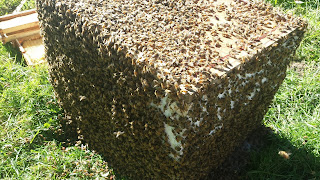It's been a while since I last wrote about the farm. I've had an issue I cannot talk about right now occupying my free time, and plenty of stuff on the farm occupying my work time.
I purchased another farm down the road from me this year; another 40 acres and a house and barn. I bought it mostly for the land; I wanted more cropland that I owned - but was pleasantly surprised to find that someone about 40 years ago had planted really nice things around the house.
So the new farm came with a mature american chestnut tree, a mature black walnut tree, the biggest fig tree I've ever seen, and a variety of other homestead-like plantings. I spent a little bit of the fall
clearing the blackberries and overgrowth and I'm looking forward to completing that work this spring. the black walnut tree and chestnut tree are about 75' tall, and the fig tree is 30' tall.
I purchased the property on an as-is, where-is basis; I figured that if the house was too terrible I'd just
tear it down, but it turns out to need some work to improve it, but it's good as it is. I did decide the
kitchen was too terrible and rehabbed it, and I've found some folks who seem happy to live there,
so I'll rent it out and see how that goes for the next year.
The purchase price for this farm was a little under 8k/acre, which is a little more than the 6k/acre
I paid for my main farm, but still within reason. With a little juggling I can probably develop
and sell an acre of it as a mobile home lot or a house building lot and pay off the property if I can
do it before the housing market in this area crashes - because I think that we're overvalued right now
in washington state, and I can't see it going up much from here.
When it's low I buy, when it's high I sell, and I've been selling property this year.
Around the farm:
Pig business is good. Currently have 60 sows and 5 boars. Seeking a market for my cull sows and
hate selling them at auction, but when they have to go, they've gotta go. holiday sales of pigs
are always pretty fun; lots of cultures have pigs as a celebration meal, so I've got groups of
happy customers processing their own pigs almost every day of december; I was offered a bit
of crisped fat and salt by a romanian family that was here yesterday; it's their favorite part of
the process-the-pig tradition, and I accepted it with a smile.
Milking cows are all dried off this time of year; I'm aiming my calving at march of the year so that the cows can be on the best grass of the year as they produce milk for their calves and me. I only milk 1 cow each year, as the 5 gallons or so of milk that single cow produces is more than I or even my extended family can consume, and you can only make so much cheese :)
I've cut my chicken flock down to a rooster and a dozen or so young laying hens; keeping chickens in the winter is a bigger chore than I need right now, so I'll wait for warmer weather to bring in the roosters. i like to raise 300 to 500 heritage roosters a year and sell them to the live chicken folks.
I'll order the chicks delivered in late feb or early march and sell them through the summer as they
reach the weights that people like to eat them at. they grow slowly compared to cornish cross, but the demand is good, and the price is good.
I'm going to move the majority of the cows to the new farm in the spring; which will free up the ground here for corn, and I'll plant 40 acres of corn next year. I'll also plant some wheat, alfalfa and orchard grass next year, and try some soybeans as well. I like the idea of growing my own feed for
my own animals, and I think I have enough land to do the job right now. It makes economic sense because I'm my own customer for the feed, and when I buy pig feed I'm paying the equivalent of $10 a bushel for corn/soybean mix and I can raise the corn for about $3/bushel, everything included, which means I think I can cut my feed bill by at least 30% for the carbohydrates, but the protein part I'm still working on.
2 months ago





















































